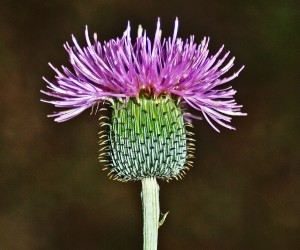— This article by Jerry Cates was first published on 29 March 2010, and revised last on 3 April 2016. © Budsinthenews Vol. 1:03.
—————————————–
Within the Aster family, several genre of perennial flowering plants are commonly known as thistles. Among these is the genus Cirsium, which contains those most accurately referred to as plume thistles.
The plume thistles are distinguished from other thistle genre by having feathered hairs attached to their cypselae (Greek kupsele = “hollow vessel”). The fruit of the Asteraceae, being derived from a compound inferior ovary with a single locule, is not technically an achene but a cypsela, and the feathered hairs of the plume thistle function much as those of the dandelion, to promote the biological dispersal of seed.
Plume thistles have effusive flower heads, and many are purple, rose, or pink, as in this specimen. The flower head is composed of a concentration of radially symmetrical disk flowers, perched at the terminus of a branch. The stems are erect, and the leaves are armed with numerous prickles that, as the plant matures, become more hardened with age
The word Cirsium has Greek origins (kirsos = “swollen vein”), and is a relic of the ancient use of thistles to treat vascular conditions.
The larvae of a number of Lepidopteran larvae feed on Cirsium thistles, and the seeds are favored by birds, particularly finches. On this basis alone the thistle should be considered an important botanical in our midst. But it figures mightily in human history as well.
Because one cannot provoke a thistle with impunity–i.e., wounding a thistle exacts punishment on the attacker–the thistle, much like the burr, became an early symbol of nobility among the Celts and the Swiss. Legends in both cultures relate tales of enemies who, barefooted, stepped upon a thistle while preparing an attack by night. The involuntary cry, thus produced, alerted the garrison, prevented an ambush, and saved the day.
Alas, to most modern Europeans and Americans, the thistle is no more than a weed…
—————————————–
Taxonomy:
- Domain: Eukaryota (yew-carr-ee-OH-tah) — from the Greek prefix ευ (yew) = good, well, pleasing + καρυον (khar-yone) = a nut/nucleus, thus organisms whose cells contain a nucleus and other organelles within membranes.
- (unranked): Bikonta Cavalier-Smith, 1993 (bye-KOHN-tuh) — from the Latin bis = twice/double + the Greek κοντος = a punting pole; those eukaryotic organisms within the subgroups Apusozoa, Rhizaria, Excavata, Archaeplastida, or Chromalveolata.
- (unranked): Archaeplastida Adl et al., 2005 (ahr-kee-PLASS-tih-duh) — from the Greek αρχαιος (AHR-kee-ose) = ancient/antiquated + πλασις (PLAS-iss) = a moulding + Anglo Saxon tid = time; a major group of eukaryotes, comprised of the red algae (Rhodophyta), the green algae, and the land plants along with the freshwater unicellular algae known as glaucophytes.
- Kingdom/Regnum: Plantae Copeland, 1956 (PLAN-tee) or Viridiplantae Cavalier-Smith, 1881 (veer-id-eye-PLAN-tee) — from the Latin planta = a green twig; the plant kingdom, consisting of multi-cellular green plants, i.e., whose cells have cellulose within their cell walls and have primary chloroplasts derived from endosymbiosis with cyanobacteria containing chlorophylls a and b and lack phycobilins..
- (unranked): Streptophyta Jeffrey 1967 (strepp-toh-PHY-tuh) — from στρεπτος (STREP-tose) = (easily) twisted, pliant + φυτον (PHU-tawn) = a plant/tree; the land plants and the green algal group Charophyta.
- Subkingdom: Embryophyta Engler, 1892 (imm-bree-oh-FYE-tuh) — from the Greek εμβρυον (EMM-bree-yon) + φυτον (PHU-tawn) = a plant/tree; green plants, informally known as land plants because most are terrestrial rather than aquatic, while the related green algae are primarily aquatic;
- (unranked): Angiosperms (AN-gee-oh-spurms)/Magnoliophyta Cronquist (mag-NOH-lee-oh-fye-tuh) — from the Greek αγγειον (AUGG-ee-awn) = a vessel/pail/reservoir + σπερμα (SPUR-mah) = a seed; the flowering plants, distinguished from the gymnosperms by having flowers, endosperm within the seeds, and the production of fruits that contain the seeds;
- (unranked): Eudicots (YEW-dee-kotts) — from the Greek prefix ευ (yew) = good, well, pleasing + δι (die/dee) = two/double + κοτυληδων (cott-ee-LEE-dun) = a cup-shaped hollow; a monophyletic clade of flowering plants previously known as tricolpates or non-magnoliid dicots, to emphasize the evolutionary divergence of tricolpat dicots from earlier, less specialized dicots; close relationships are presumed among flowering plants with tricolpate pollen grains (the grains have three colpi, or elongated apertures or furrows in the pollen grain paralleling the polar axis);
- (unranked): Asterids (ASS-turr-iddz) — from the Greek αστηρ (ASS-turr) = a star/meteor + the Latin suffix -idus (EE-duss) = indicative of having the nature of; one of the two most species group of eudicots (which have inflorescences having the appearance of a meteor or shooting star), the other being the rosids;
- Order: Asterales Link (ass-turr-AWL-ees) — an order of dicot flowering plants known for composite flowers made of florets;
- Family: Asteraceae Bercht. & J. Presl (ass-turr-ASE-uh-ee)— the daisy or sunflower family, commonly known as the Compositae and referred to as the aster, daisy, composite or sunflower family; comprised of more than 23,600 species in 1,620 genera and 11-13 subfamilies; many members have composite flowers with flower heads surrounded by involucral bracts which, viewed from a distance, often makes it appear that each capitulum is a single flower; most are harbaceous, but many are shrubs, vines, or trees;
- Subfamily: Carduoideae (karr-dew-OY-duh-ee) — the thistle subfamily, one of the 11-13 subfamilies of the Asteraceae family of flowering plants;
- Tribe: Cynareae Lam. & DC (sinn-ARR-uh-ee) — a tribe of flowering plants mostly known as thistles, comprised of three or five subtribes, depending on the taxonomist;
- Genus: Cirsium Mill. (SURR-see-um) — perennial and biennial flowering plants in the Asteraceae, one of several genera known commonly as thistles. Species in the genus Cirsium are more accurately known as Plume thistles, as they differ from other thistle genera (Carduus, Silybum and Onopordum) in having feathered hairs attached to their cypselae. The other genera have a pappus of simple unbranched hairs.
—————————————–
Feel free to e-mail jerry.cates@entomobiotics.com regarding your comments on this article. You may also register, log in, and leave a detailed comment in the space provided below.
